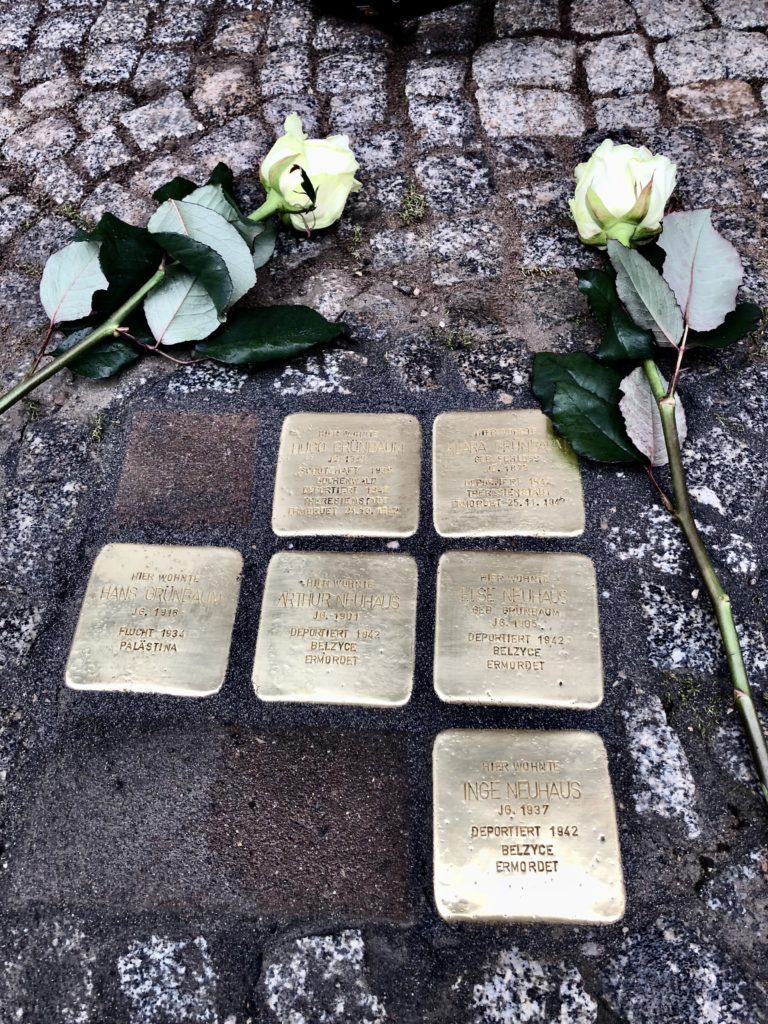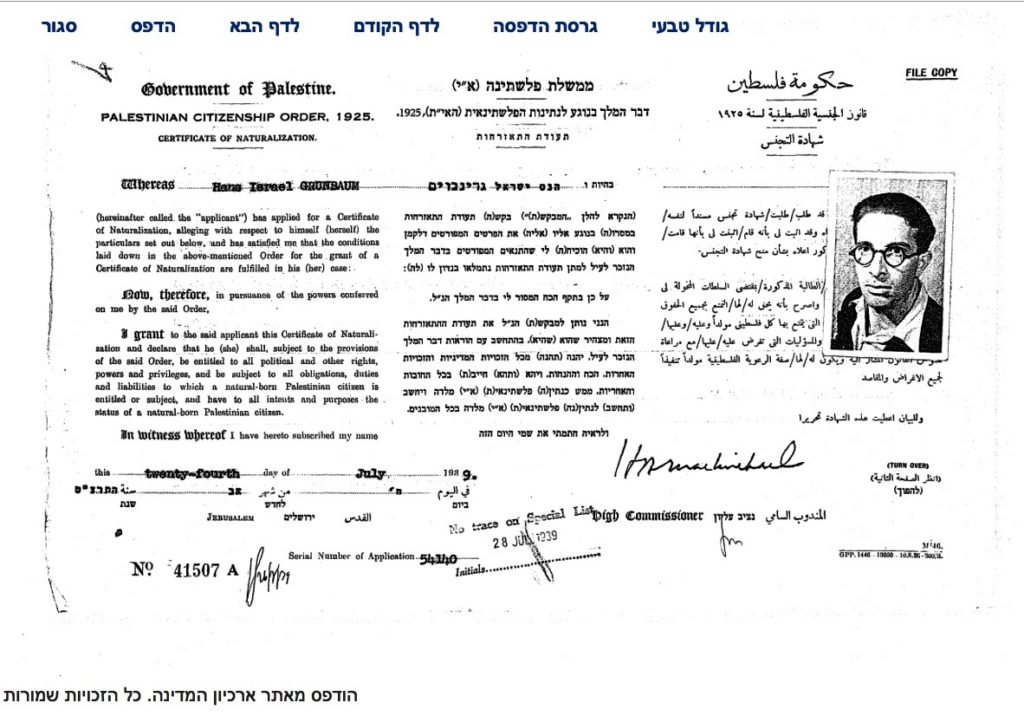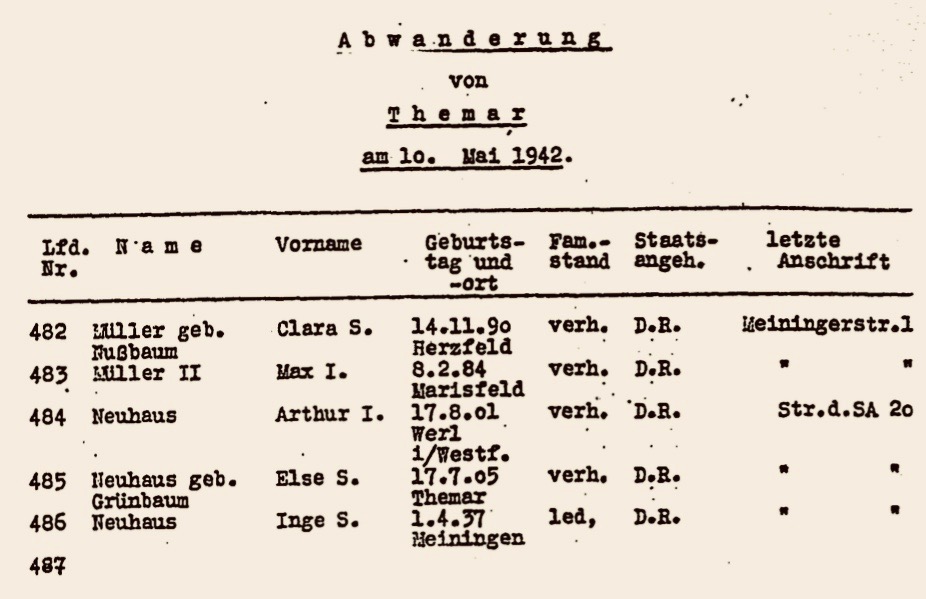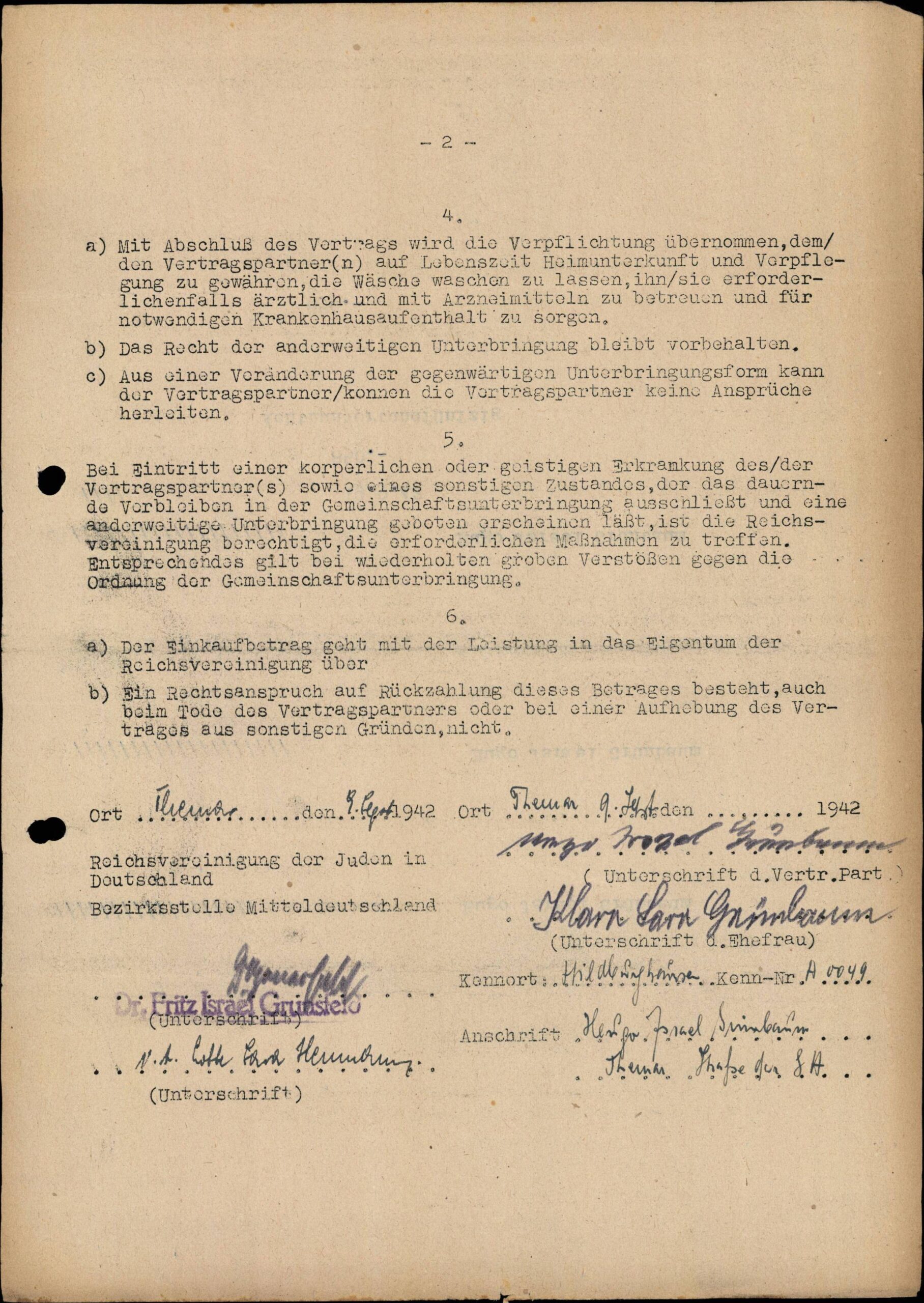Also:
The Family of Noah Grünbaum
The Family of Bertha (née Grünbaum) and Jakoby Seckel
The Family of Minna (née Grünbaum) and Samuel Rosenthal
The Family of Karl and Hulda (née Schlesinger) Grünbaum
List of Descendants: Heinrich u. Ida (née Schmalbach) Schloss
List of Descendants: Noah Grünbaum
Stolpersteine for family of Hugo and Klara Grünbaum
Hugo Grünbaum lived about 70 years-1871/2 to 1942-in Themar. His family, as a child of Noah Grünbaum, was one of the most important families for the Jewish community in Themar.
Hugo was born in Walldorf/Werra in 1868, the son of Noah and Minna (née Friedmann) Grünbaum. He moved with his parents to Themar sometime before 1872, as his sister Minna was born in Themar in 1872. When his father remarried, Hugo had a stepbrother, Karl, born in 1876.
At first Hugo lived with his parents and siblings at Hintertorstraße 170 (later Bahnhofstraße) where Noah founded a haberdashery store. Later Noah moved his store and family closer to the railroad station to Bahnhofstraße 150.
In 1897 Hugo Grünbaum and Klara Schloß were married; Klara was one of eleven children of Heinrich (Hohna) & Ida (née Schmalbach) Schloß from Schwanfeld. In the Jewish register Themar the following is written:
“Hugo Grünbaum merchant son of the merchant Noa Grünbaum and his deceased wife Minna geb Friedmann, 29 years old, and Klara geb Schloß daughter of the merchant Heinrich Schloß and his wife Ida geb Schmalbach to Schwanfeld 24 years old.”
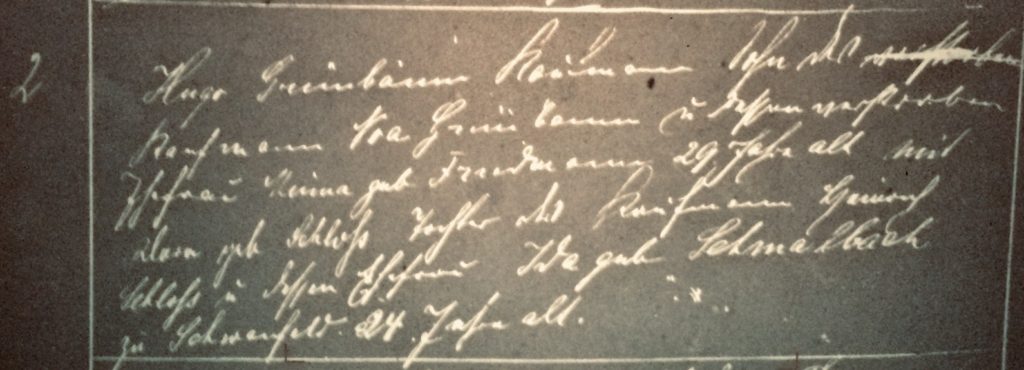
They lived in Bernhardt Street where two children were born; the first in 1901 was stillborn, the second, Mira, was born on 17 Mar 1903.
Hugo’s father Noah died on 29 Jan 1901. Exactly what happened to the N.H. Grünbaum department store in the early 20th century has yet to be determined. Normally, the eldest son, in this case Hugo, would have inherited the family business. However, on 14 October 1901, Hugo Grünbaum registered a goods business under his own name. Stepbrother Karl, who was 29 years old at the time, and his wife Hulda, continued to run the N.H. Grünbaum department store together.
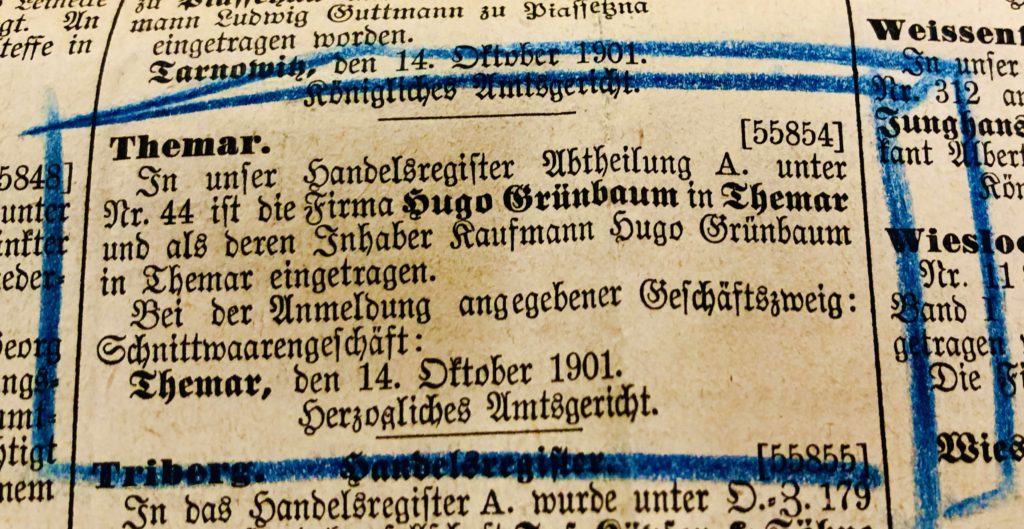
Four years later, when Hugo’s cousin, Bertha (née Grünbaum), and her husband, Jakoby Seckel, moved away from Themar, Hugo took over the Seckel store.
On 01 May 1905, Hugo announced the “business relocation and opening” of the store under his name and the move from Marktplatz to Bahnhofstraße 143, almost directly across from the N. H. Grünbaum department store.


In 1912, Karl Grünbaum sold his business to Markus Rosenberg and one year later moved to Erfurt with his wife Hulda. Thus, in 1914, there was only one Grünbaum family in Themar — Hugo and Klara Grünbaum with their two daughters, Mira, born in 1903, and Else, born in 1905.
Like most German Jews, Hugo and Klara were excited by the outbreak of the war. When they announced the birth of their son Hans on 12 February 1916, they chose very patriotic words for the announcement.
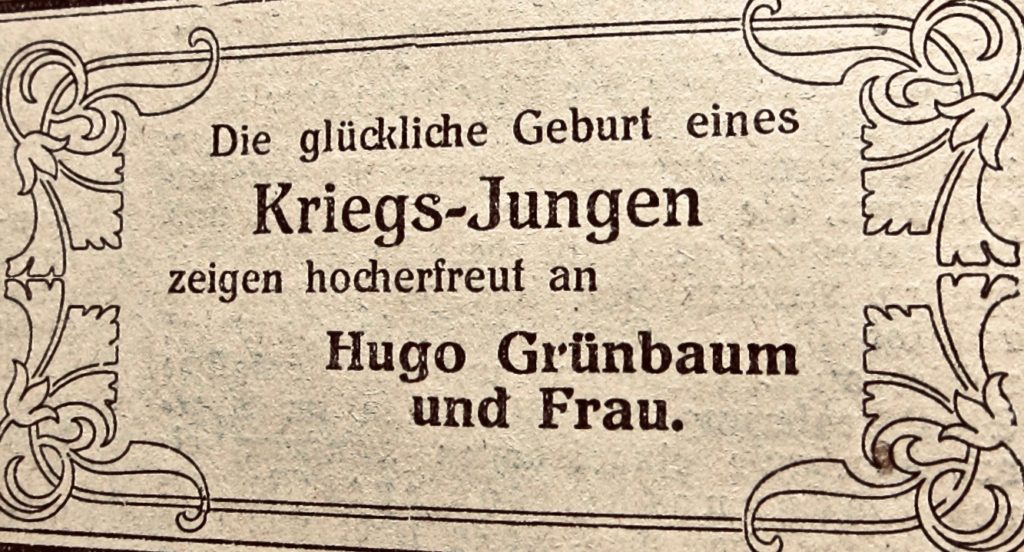
1933-1942: In the Third Reich
When the National Socialists took power in January 1933, Hugo and Klara Grünbaum reacted like most German Jewish families. They worried first about the safety of their children and then about their own safety. “Security” at that point meant leaving Germany and either fleeing to another country in Europe, or best of all, leaving Europe altogether. Two of Hugo and Klara Grünbaum’s children were among the first Jews to leave Germany. Hans Grünbaum went to Haifa, Palestine in 1934; he became a citizen of Palestine on 24 July 1939.
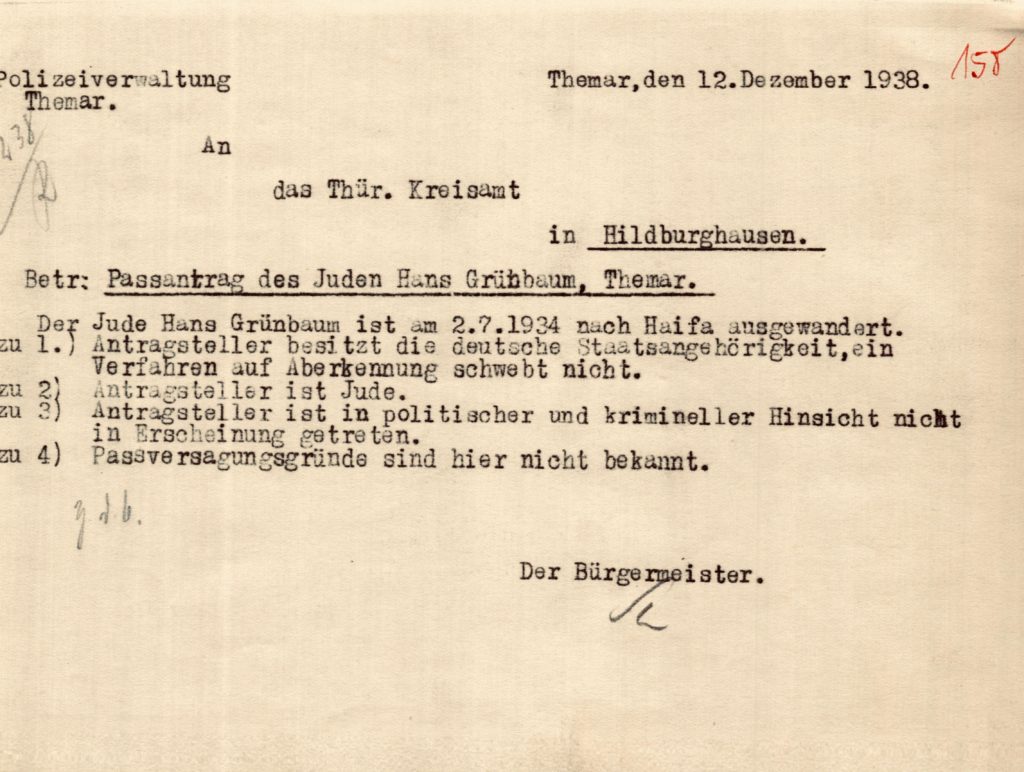
Mira Grünbaum left Germany in 1936. She was married to Arno Sommer (from the Gassenheimer family in the neighboring town of Hildburghausen) and they lived in Hannover, where a son was born, until 1936. Mira, Arno, and one-year-old Siegfried — and mother-in-law Hedwig Sommer, née Gassenheimer — went to Italy.
*****
In Themar in 1936 lived Hugo and Klara, and daughter Else with her husband Arthur Neuhaus. Arthur, born in Werl on August 17, 1901, had married Else in September 1935 and moved to Themar; he worked in his father-in-law’s business “Hugo Grünbaum.” Ingeborg Neuhaus was born on 01 April 1937.

Life for the Grünbaum and Neuhaus families in Themar became increasingly difficult. On 03 November 1938, Hugo had to liquidate his business. On the night of November 9/10, Hugo was one of the eighteen (18) men arrested and taken to Buchenwald. Sometime before 01 December 1938, he was released with other Themar Jews. Where Arthur Neuhaus was during these days we do not yet know.
On March 20, 1939, the Grünbaum and Neuhaus families had to leave the house in Bahnhofstraße; Clara Müller wrote to her son Willi in Palestine: “The synagogue here is to be sold and [Hugo] Grünbaum will move in upstairs because he has to get out of his house.” Else, Arthur and Inge Neuhaus moved to the house in S. A. Straße 20 (today Leninstr.). On 17 September 1939 Arthur Neuhaus had to move to Neuendorf where he did forced labor with Julius Rosenberg, Adolf Kahn, and Louis Sander for at least six (6) weeks.
Source: Municipal Archives Themar
From 05 March 1940 on, as Clara Müller reported to Willi Müller in Palestine, “Herbert, [Arthur] Neuhaus, [Louis] Sander and Julius Rosenberg are working on road construction near Siegritz [5 km southeast of Themar], after they had been trying to find work for weeks. On the 1st day, of course, there were calluses on the hands, but Herbert comes along well & he likes it.” In a letter to Meinhold Müller in Sweden on 10 June 1940, Clara again wrote something about the Grünbaums: “Maxens [Max Müller I, b. 1873] works with [Markus/Max] Rosenberg on half the synagogue garden (the other half has Grünbaum and Neuhaus). Half the Kille meets there every day, it’s nice to sit there in the garden, we also go there sometimes.” In 1941 Arthur Neuhaus became a forced laborer in the Erfurt woodworking company. And on 10 October 1941, someone told the tax secretary that he had found the Jew Hugo Israel Grünbaum in the butcher shop of Ernst Kahl and that he was not wearing the Jewish star visibly.” There are no other documents in the municipal archives that indicate whether Hugo was imprisoned.
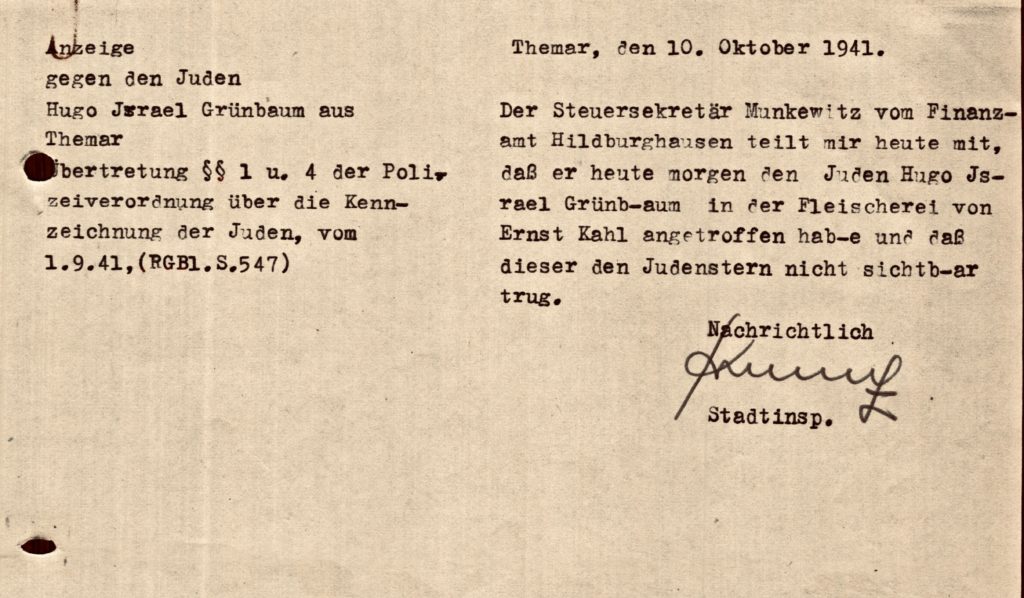
May 1942: Deportation to the Belzyce Ghetto
On 08 May 1942, Max II and Clara Müller wrote to Meinhold:
,,Dear Meinhold!
As we already wrote,
we are leaving tomorrow morning with
Neuhaus family. We cannot give you
an address, but as soon as we can,
we will give you our new
address. In the meantime write to
Uncle Max. Since it is very urgent
I will write briefly today. Many
Greetings from your dad.
Heartfelt kisses Mama”
The families Max Müller II and Neuhaus “were notified in writing. They were instructed to take with them 50 RM, luggage up to 50 kg, clothing, suitable footwear, bedding, cutlery and food for three to four days. Everything else they had to leave behind as Reich property.”
The Jews from Thuringia, approximately 342 men, women and children, were transported to Weimar on May 8 or 9, 1942, in regular passenger trains from several cities and towns. […] This happened in broad daylight.
[…] In Weimar, the Jews from Thuringia were interned in the local Gestapo headquarters, a former riding hall of the Marstall, in the east of the city. […] About 513 men, women and children were taken in the early morning hours of May 10, 1942, from the collection point through the city, to the already waiting train at the freight station, Ettersburger Straße. There they were crowded into freight cars. From Weimar the train went to Leipzig. Here, at the Engelsdorf freight station, about 369 more Jews boarded the train,[…].
The deportees from Saxony and Thuringia arrived in Belzyce on May 12, 1942. One day before their arrival in the ghetto, several young men from Belzyce had been deported to the Majdanek camp to make room for the Jews arriving from the Reich. […] The ghetto inhabitants of Belzyce had to live closely packed and in terrible hygienic conditions. Many people died due to hunger and diseases. Beginning in October 1942, most of the ghetto residents were murdered in the death camps in the surrounding area.”
Else Neuhaus, née Grünbaum, her husband Arthur Neuhaus and their five-year-old daughter Inge, were deported and murdered. Else’s cousins from Apolda — Grete, Norbert, and Max Rosenthal and his wife Ilse, née Benjamin — were in the same transport and were also murdered.
Source: Statistics and Deportation-Erfurt – Weimar – Leipzig – Chemnitz to Bełżyce
September 1942: Deportation to the Theresienstadt Ghetto
In early September 1942, Hugo and Klara Grünbaum learned that they would soon be moving to the so-called retirement community of Theresienstadt. On 9 September, they were forced to sign away the last of their assets — RM 850 in cash — to purchase a home for themselves in the new community. Had they baulked at signing the contract, they were threatened with deportation to the “East”, the sense of which was now well known to them given the deportation of their daughter in May.
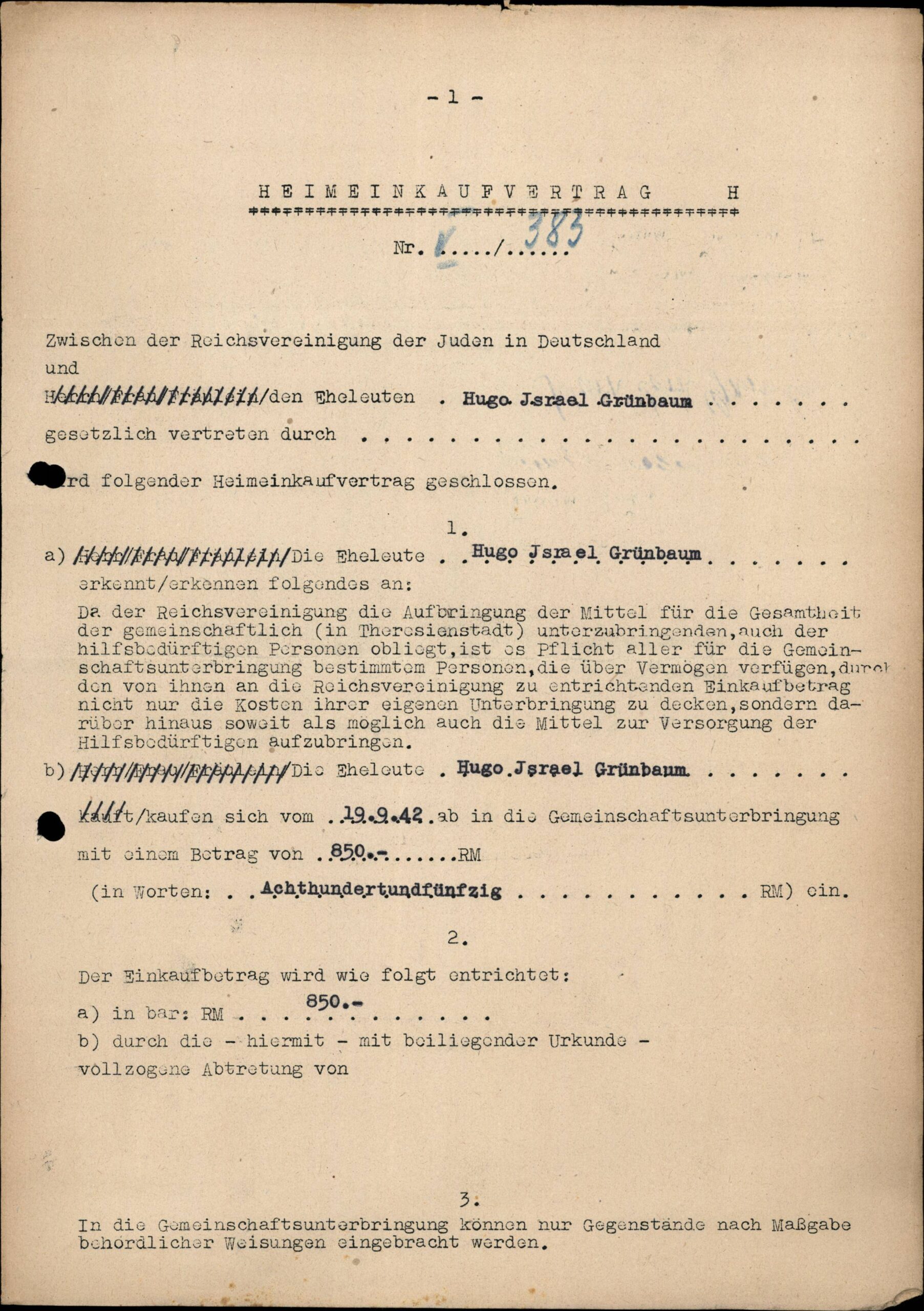
All the documents related to Hugo’s and Klara’s purchase of a so-called “Retirement Home Contract” in the Theresienstadt Ghetto are available in the Arolsen Archives.
As in May 1942, the district councils and mayors sent detailed instructions to the local police and gendarmerie officials on how to carry out the deportation. On 19 September 1942, Hugo and Klara left Themar forever; they joined a train that had started in Hildburghausen to the south; already on the train were “two Jews were escorted on foot from Gleicherwiesen to Hildburghausen,” and five more Jews from Hildburghausen. “The train continued to Themar, where eight Themar Jews — including Hugo and Klara Grünbaum — and three from Marisfeld boarded. Two local policemen escorted the total of 18 Jews to the Gestapo in Weimar; the process was filed as routine police work.”
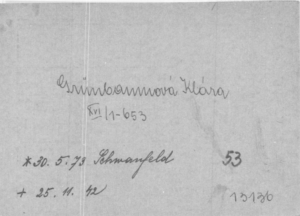
On September 20, the eve of Yom Kippur, one of the holiest days in the Jewish calendar, they left Weimar for the Theresienstadt ghetto. Hugo and Klara were crammed into a train with the other 357 Thuringian Jews. In Leipzig, 520 more Jews arrived. The deportation train arrived in the village of Bauschowitz, since the Theresienstadt ghetto itself had no rail connection until the summer of 1943. The prisoners had to cover the three kilometers to the Theresienstadt ghetto on foot and under guard. (For further information about the transport of 19/20 September 1942 from Weimar/Leipzig to Theresienstadt, see Yad Vashem, Trains to Extinction, Transport XVI/1, Train Da 517 from Weimar, Weimar (Weimar), Thuringia, Germany to Theresienstadt, Ghetto, Czechoslovakia on 19/09/1942.)
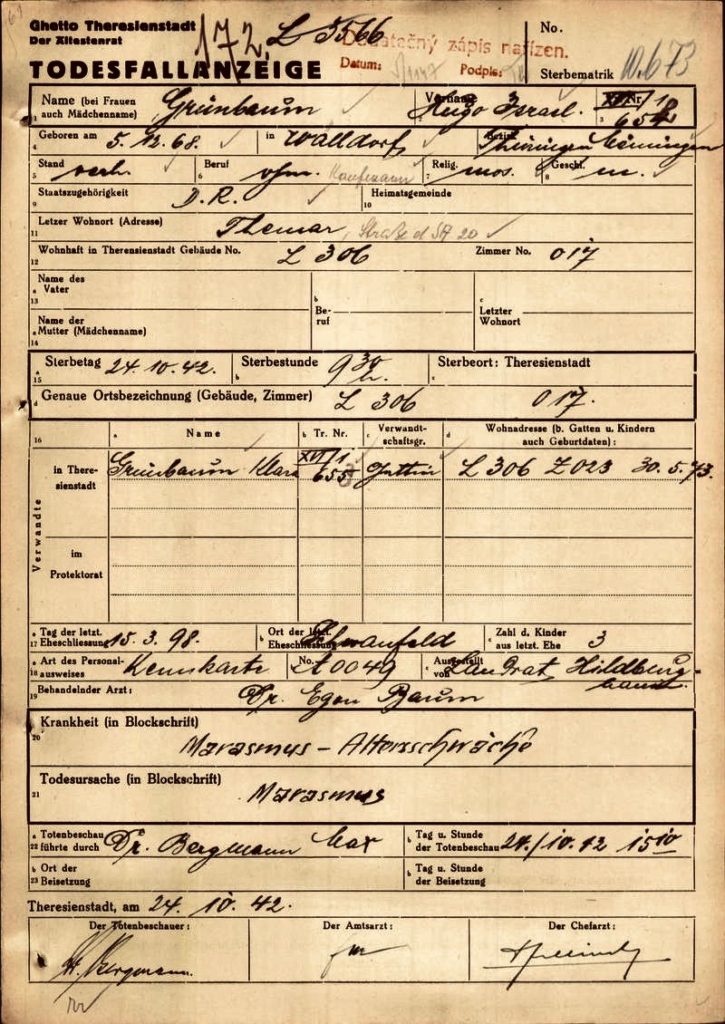
In the same transport were Hugo’s siblings Minna Rosenthal (née Grünbaum) from Apolda and Karl Grünbaum and his wife Hulda (née Schlesinger) from Erfurt. The three siblings were all murdered in Ghetto Theresienstadt: Hugo was the first to die, a month after arriving. Karl died on 29 March 1943, and Minna on 01 June 1943. Of the family of Klara Grünbaum (née Schloß), her brother Ludwig Schloß and his wife Lina Schloß (née Neuberger) and a sister-in-law, Klara Schloß, née Sämens, widow of Simon Schloß, were also murdered in the Theresienstadt ghetto. Jacob Sommer, the father of Mira’s husband Arno, and an uncle, Louis Gassenheimer, were also murdered in the Theresienstadt ghetto. (Hedwig Sommer, née Gassenheimer, Arno’s mother and Louis’ sister, was deported from Italy to Auschwitz in 1943 and murdered).
*****
At the end of the war siblings Hans and Mira Grünbaum were alive. Hans was in Palestine and we only know that he died in Israel in 1980.1 Garry Meller, email to Sharon Meen, 22.09.2014 .
We know a little more about the lives of Mira, Arno and Siegfried Sommer. In 1945, Mira was still in Italy with Arno and Siegfried. This file, in the Arolsen Archives, tells us something of their years in Italy, and their constant movement from place to place.
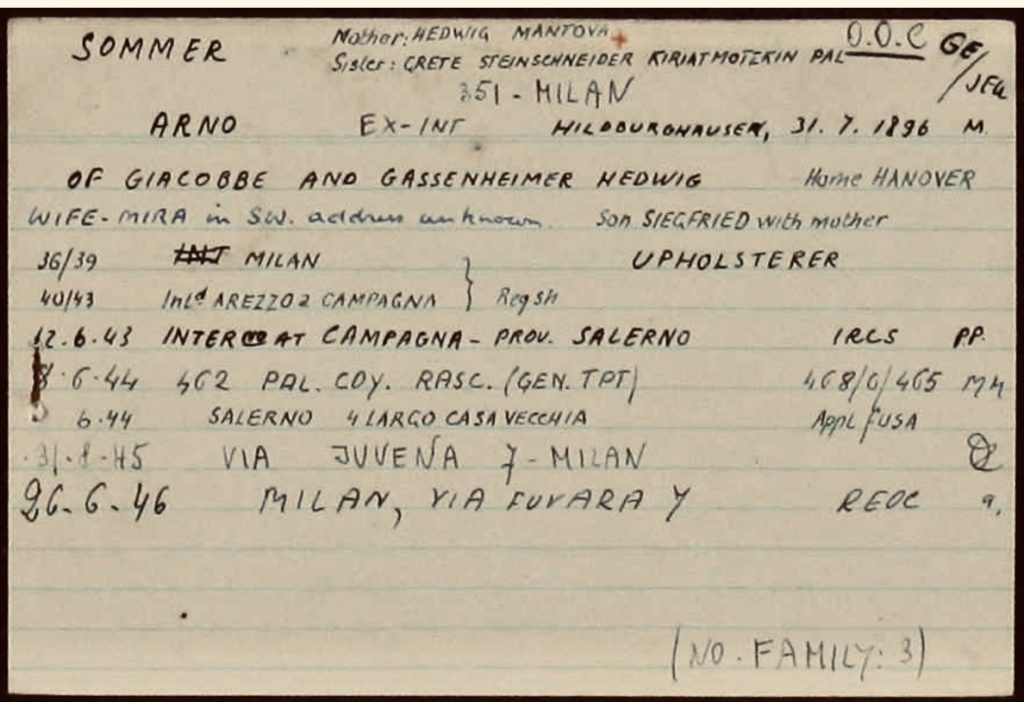
They immigrated to the United States from Naples in May 1948.
In 1956, and perhaps earlier, the Sommers lived in an apartment in an apartment at 5 Mott Street in Worcester, Massachusetts. (A relative of Arno’s, Arnold Sommer, used to live in this house.) Arno was again an upholsterer and Siegfried, age 24, was a student at Clark University in Worchester.

In 1961, Siegfried was a trainee at John Hancock Life Insurance Company, an insurance company in Boston.

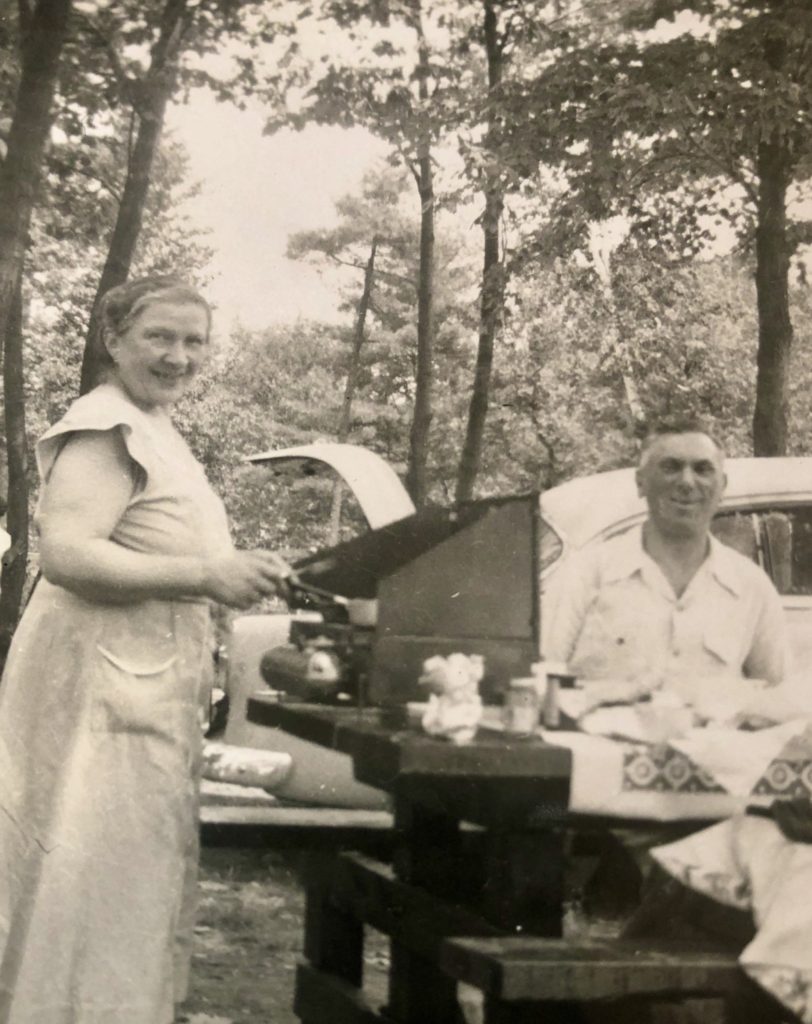
In 1970, Siegfried married Dorothy Zito in Boston and they lived in this city. At some point they moved to Allston, a small town near Boston.
On 9 February 1991, Arno Sommer died in Worchester, and after that Mira spent some time living in Allston. On 4 August 200o Mira Sommer, née Grünbaum, died in Worchester; she was 97 years old.

Siegfried and Dorothy continued to live in Allston; in 2012 Dorothy died and on 14 August 2014 Siegfried passed away.
On 27 November 2019, Stolpersteine for the Grünbaum and Neuhaus families were laid in front of the house on Bahnhofstrasse. A descendant of the family of Noah Grünbaum came from Australia to Themar to participate in the laying.
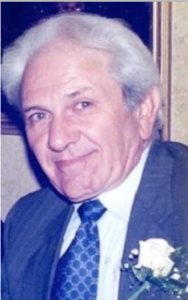
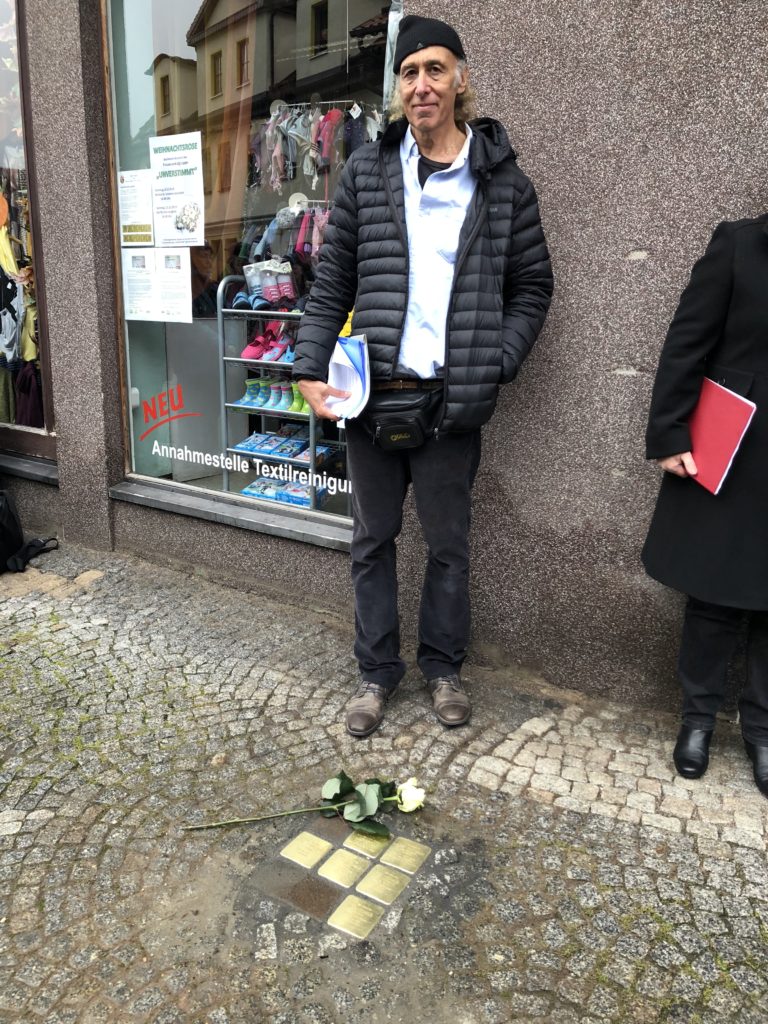
Sources:
Privat Besitz Grünbaum/Meller
****
Arolsen Archiv
Ancestry.com
Gedenkbuch: Opfer der Verfolgung der Juden unter der nationalsozialistischen Gewaltherrschaft in Deutschland 1933-1945
Jüdische Gemeinde Marisfeld (Kr. Hildburghausen). Matrikel 1768-1938, Koblenz: Bundesarchiv 1958.
Jüdische Gemeinde Themar (Kr. Hildburghausen). Matrikel 1820-1938, Koblenz: Bundesarchiv 1958.
Jüdische Gemeinde Walldorf Werra (Kr. Meiningen), ”Matrikel, 1839-1938”.
Liesenberg, Carsten und Harry Stein, Deportation und Vernichtung der Thüringer Juden 1942.
Regierungsblatt für das Herzogthum Sachsen-Meiningen (RG/SM, Staatsarchiv Meiningen
Yad Vashem, Transport, Zug Da 27 von Weimar, Weimar (Weimar), Thüringen, Deutsches Reich nach Belzyce, Lublin, Lublin, Polen am 10/05/1942
